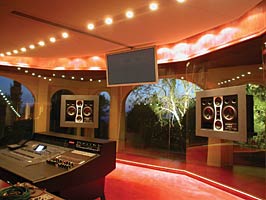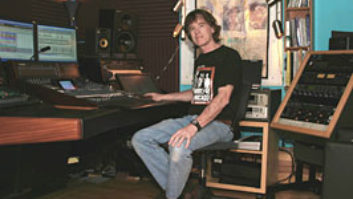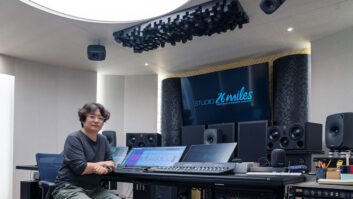
Rome-born musician, composer, arranger, conductor and producer Romano Musumarra quickly showed his musical flair when, at the age of nine, he entered the Eternal City’s world-famous Santa Cecilia Conservatory. He graduated in piano playing and took specialized courses in composition and conducting; he also attended the Pontifical Institute of Sacred Music.
Musumarra embarked on a successful pop career in the mid-’70s with La Bottega dell’Arte, a band that charted several Italian hits. In the early ’80s, he began work as a composer/arranger with top Italian artists such as Riccardo Cocciante, Luca Barbarossa and Fiorella Mannoia.
Yet, Musumarra is relatively little-known in his home country, probably due to the fact that the majority of his work has involved international artists and because he moved to France for a period in 1983. There, thanks to his classical background, he began to make a name for himself by composing, orchestrating and conducting radio and TV projects before embarking on a European career as a movie score composer. In addition to the score for the musical Cindy, which had a three-month run at Le Palais des Congrès de Paris, film works to his credit include L’Élève, The Teddy Bear, Day of Atonement, Adventurer Jean Galmot, Dark Woods, Faceless, Malady of Love and Women of My Life.
His artistic talent was recognized when he received the title of “Chevalier des Ordres des Arts e des Lettres” in 1998 from the French Ministry of Culture. The impressive roster of French-speaking artists he has worked with includes Mireille Mathieu, Sylvie Vartan and Jeanne Mas. Through the years, international artists with whom Masumarra has worked include Celine Dion, Gino Vanelli, Ray Charles, Carol Welsman, top UK soprano Katherine Jenkins and Luciano Pavarotti. One of his latest projects is tenor Vittorio Grigolo’s album In the Hands of Love; Musumarra performed live in New York City at the album’s U.S. launch.
After an 11-year stay in France, Musumarra returned to his native Italy and bought a farm in the beautiful rolling Umbrian countryside. After settling in with his family, he decided to build his own recording studio. “When we moved here, I had my own workspace,” Musumarra says, “but used other studios for recording. However, since there was plenty of space, I eventually made the decision to build a serious on-site facility, thanks also to my acquaintance with acoustic architect Giuseppe Zappata, whose work I consider to be of international standard.” Zappata, of Rome-based Zappata and Partners, was selected to design the studio.
Musumarra’s goal was to design and build a studio that would not only be acoustically correct, with a preference for bright tones, but also would be literally luminous, with as much natural light as possible. Without a doubt, the most striking feature upon entering Romus Studio’s control room for the first time is the huge glazed area where the ADAM S6A MK2 main monitors are mounted, supported by custom steel arms. The glazing forms a very spectacular (and efficient) isolation chamber and gives a breathtaking view of a wooded valley, and nearby Orvieto’s 14th-century fortress and cathedral.
Zappata explains, “The studio has two key features, both with considerable visual impact. The first is the special twin glazing with the flush-mounted main monitors, an idea that, as far as I know, has never before been applied in such a spectacular manner, while nevertheless ensuring perfect sound. The second is the studio’s acoustic treatment via one very large, complex resonator/diffuser, which ensures linear acoustics and control of all frequencies produced in the room by means of its varied cross-section.”
Going into the more technical aspects of his application of Italian style to acoustic design, Zappata continues, “The studio’s long, horizontal ‘poly-cylinder’ forms a multiple absorption unit, which works along with the rigid multi-angle sawtooth ceiling. Low frequencies are therefore controlled by differentiated absorption due to the shape of the cylinder and its internal frequency selection, whereas mid-highs are controlled by means of the diffraction and diffusion of the ‘wave system’ of the cylinder and the inclined surfaces of ceiling; this interaction ensures a suitably short delay time without any sound ‘tails.’”

The construction of a sound box ensures perfect acoustics for Romano Musumarra’s Bösendorfer piano.
The ceiling and cylinder control the static sound waves between the floor and the walls, while for the other shorter walls — at the entrance of the sound lock for the control room — this was done by ensuring the structures were not parallel. This combination of functions and shape is at the basis of the construction of a “sound box,” which is able to ensure perfect acoustics for the beautiful Bösendorfer full grand piano that it hosts.
All the carpentry work in the studio was done by the all-female team of specialist firm La Madia. Control room acoustics, on the other hand, apply the SAE (Stealth Acoustic Environment) technique, based on military applications that enable planes and ships to give low radar return and developed by studio designer Zappata, who says he “sculpted” the area around the sound engineer’s listening point to trap the flow of acoustic energy
“The form of glazing that makes up the internal reflecting shell and the external insulating part creates a cavity with considerable dimensions, which operates as both an acoustic and thermal barrier,” Zappata explains. “The passage between the two glass walls facilitates access to the speakers and ‘invisible’ cabling, as well as the work of cleaning the glass. And an invisible absorption system eliminates the residual resonance that occurs inside the space between the two glass walls.”
Thanks to the shape of the glass wall, all of the energy from the ADAM S6A MK2 enclosures is fed directly to the sound engineer’s listening position — free from early reflections, which are within the limits of integration precedence effect (Haas effect). The sound reflected by the glass wall is within 35 ms and doesn’t reach the center of the desk, where it could mix with direct sound, but is instead collected behind the mixing position and dissipated by an impressive waveguide baffle system, which makes the rear part of the control room particularly absorbent, avoiding any energy return.
Musumarra leaves no doubts as to the reasoning behind his choice of hardware for the studio, explaining, “I don’t intend using Romus Studio for recordings by third parties, so I decided against the high-end analog consoles that the commercial recording market expects nowadays. Apart from their cost, they’re also very demanding to run. I therefore decided to concentrate my investment on the structure of the studio. When you use top-quality mics, preamps and converters, I think the desk should be used as a mixing tool that doesn’t influence the sound.”
The console eventually chosen was a Yamaha DM2000, and the facility’s interesting assortment of outboard gear includes handmade preamps by Livio Argentini, which Musumarra loves. Other goodies include two Millennia Media TD-1s, a Chandler EMI TG2, Universal Audio 2-610, Focusrite ISA 115 HD, GML 8200, two Sherman Filter Banks, two Focusrite ISA 131s and a GML 8900. Mics include two of just 100 DPA Type 4040 models available worldwide.
Musumarra records direct to hard disk with Logic Audio, software he considers “a step ahead of the others.” His system comprises a Mac G5 dual 2GHz with a 64-channel RME Hammerfall DSP MADI and a Prism Sound Dream ADA-8XR high-resolution multichannel AD/DA converter. A pair of Genelec 1031A monitors are used with the computer.
The impressive ADAM S6A MK2 main monitors are uncommon in Italian studios, and Musumarra frankly admits he bought them without ever having heard them: “I’d used the manufacturer’s S3A enclosures [five of which are installed in the control room for 5.1 projects, along with an ADAM Sub10] when doing my mixing work in the past, and wanted something that maintained the characteristics I was accustomed to; I’m very happy with the choice, and their ribbon drivers are extremely linear.”
The control room is also fitted with a large, motorized high-res video monitor, which can be moved along the track on the ceiling to enable 5.1 videos to be followed from the divan behind the console.
Although his first project in the newly inaugurated studio was mixing the audio for a show recorded by Grigolo for Polydor UK, Musumarra emphasizes that recording will take up most of his studio time. The first tracking job on the books was a group of sopranos for Decca UK at the end of the summer — a project he is enthusiastically looking forward to: “I think we’ve definitely come up with a working environment that is both efficient and beautiful!”
Mike Clark is a UK journalist based in Italy, and can be contacted at
[email protected].







